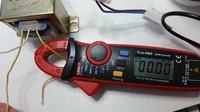How to measure a transformer
Hello,
I have such a transformer:

and I would like to measure its parameters and learn something.
There is 8.5V AC between the central tap and one end. 17.5V AC between both ends. By connecting the H1 55W bulb to 2 ends, bypassing the tap, the voltage drops to 8.5V and the bulb shines with approximately the same power as connected to the DC voltage source, limited to 4A. The voltage source is set to 12V DC, this 4A shows 8V.
None of my cheap multimeters measure AC current through wires. I have such a UNI-T UT210E, but connecting it like this:

obviously with a glowing bulb, it shows 0.002.
- How to connect this multimeter to measure the current?
- Is it possible to calculate its power on the basis of these measurements?
17.5V x 1.404 = 24.5V, that is, counting the decrease on 2 diodes (2 x 0.7V) in the rectifier bridge, I should get 23.1V DC without load, am I counting it correctly?
Hello,
I have such a transformer:

and I would like to measure its parameters and learn something.
There is 8.5V AC between the central tap and one end. 17.5V AC between both ends. By connecting the H1 55W bulb to 2 ends, bypassing the tap, the voltage drops to 8.5V and the bulb shines with approximately the same power as connected to the DC voltage source, limited to 4A. The voltage source is set to 12V DC, this 4A shows 8V.
None of my cheap multimeters measure AC current through wires. I have such a UNI-T UT210E, but connecting it like this:

obviously with a glowing bulb, it shows 0.002.
- How to connect this multimeter to measure the current?
- Is it possible to calculate its power on the basis of these measurements?
17.5V x 1.404 = 24.5V, that is, counting the decrease on 2 diodes (2 x 0.7V) in the rectifier bridge, I should get 23.1V DC without load, am I counting it correctly?



